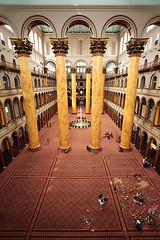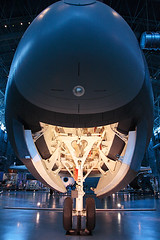I've been meaning to slap the 50/1.8 (thrifty-fifty) back onto the 5D for a while. Lately it seems like I've been shooting everything with the 24-105/4, but there's no substitute for getting back to basics. Yesterday I took the opportunity at the United States Botanical Garden. By using the 5D's monochrome Picture Style with a red (digital) filter, I was able to bring out some of the contrasty patterns in the plants. I can only imagine what could be done with a real macro lens.
The botanical garden is often overlooked in DC, but it's worth a quick stop. It's not that large, but has a great variety of plants and environments. I was expecting it to be deathly hot inside in the middle of summer (i.e. greenhouse effect), but it was surprisingly pleasant, especially in the dehumidified desert section.
Sunday, August 30, 2009
National Building Museum
Made a stop at the National Building Museum yesterday. I'd been once in early 2005, and I've been meaning to go back ever since. This time I was shooting with a 17mm lens and a full-frame camera. Last time I was there, I had a 20mm lens on my trusty D2H; not what I could call ultra-wide. Even without a wide lens though, it's still got some great patterns and repetition that are just begging to be photographed. The daylight pours in through the building's enormous windows too, so you won't be hurting for photons.
We also had the good fortune of catching the museum's photography exhibits for Philip Trager and Camilo José Vergara. Trager's architectural photography was excellent, and the prints were very well executed. Vergara's exhibit of storefront churches was less about form and composition, and more about interesting subjects. Both are worth checking out.
Most tourists and locals completely miss the National Building Museum. If you find yourself in DC, you need to make a stop. It's just a few blocks north of the National Gallery of Art and the National Mall, so it's an easy (and safe) walk.
We also had the good fortune of catching the museum's photography exhibits for Philip Trager and Camilo José Vergara. Trager's architectural photography was excellent, and the prints were very well executed. Vergara's exhibit of storefront churches was less about form and composition, and more about interesting subjects. Both are worth checking out.
Most tourists and locals completely miss the National Building Museum. If you find yourself in DC, you need to make a stop. It's just a few blocks north of the National Gallery of Art and the National Mall, so it's an easy (and safe) walk.
Tuesday, August 25, 2009
Turnagain Arm
Turnagain Arm will take your breath away. Just head south out of Anchorage along Alaska route 1 (Seward Highway) and you can't miss it. Be sure to stop at Beluga Point. Watch for whales and bore tides. Don't walk on the sand/silt, as the extreme tides can turn it into dangerous quicksand. Also stop at Bird Point. It's got some similar views, as well as displays that explain the scenery, whales, and bore tides.
Here are a couple shots I grabbed with my Xpan:

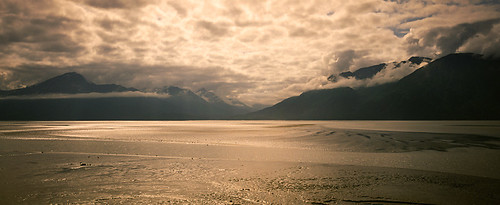
Here are a couple shots I grabbed with my Xpan:


Alaska Gear
I think some people have been wondering what camera gear I took with me to Alaska, so here's a quick post to fill in the blanks:
I think that about covers it. Notice that there's no laptop in that list. I did have my iPod Touch with me, but Internet access was fairly scarce. I didn't go all the way to Alaska to browse the web though.
Now get packing!
- Canon 5D with extra battery and charger
- Canon G9 with charger
- Canon SD800 with charger
- Canon 17-40/4 L USM
- Canon 24-105/4 L IS USM (my default lens)
- Canon 70-200/2.8 L USM
- Canon 50/1.8 II
- Hasselblad Xpan with 45mm lens
- Gitzo 1155 Traveler tripod with G1077M ball head
- Manfrotto 488RC0 ball head (heavy backup head, never used on trip)
- Approximately 15 GB of compact flash
- Two rolls of Fuji Velvia 50
- Two rolls of Fuji Velvia 100
- Dust brush with blower
- Lens cloth with cleaning fluid (had to check this)
I think that about covers it. Notice that there's no laptop in that list. I did have my iPod Touch with me, but Internet access was fairly scarce. I didn't go all the way to Alaska to browse the web though.
Now get packing!
Monday, August 24, 2009
The Other Air and Space Museum
The Udvar-Hazy Air and Space Museum is well worth the trip. My friend and I drove out there yesterday. It had been on my list of places to visit for far too long.
The museum was much larger than I expected. It's about the size of the Air and Space Museum on the National Mall, but much more open.
As with all the Smithsonian museums, admission was free. Parking was $15 though, some of which probably gets kicked back to the museum. This gets no complaints from me; they deserve it. I think the parking fee is also there to discourage people from using it as a parking lot for Dulles Airport, which is literally right next door.
I was very impressed with the way they had all the aircraft lit. Most museums seem to be satisfied with harsh top lighting, but not here. They had the undersides and crevices illuminated so everyone could appreciate (and photograph) the details of things like air intakes and landing gear. If you ever want to learn how to properly light an aircraft, you need to check it out.
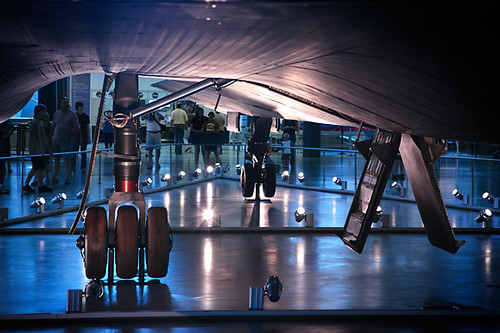
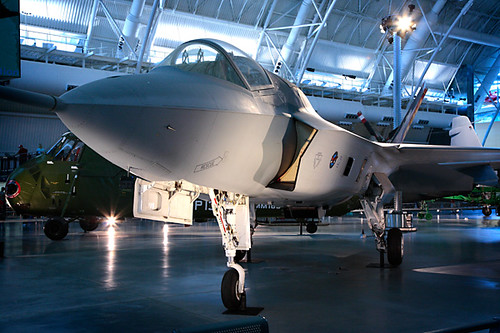
I was impressed with how many aircraft they'd fit into a single building, though it did get out of hand at times (see left). I was especially looking forward to seeing the Concord, but was disappointed to see that it had so many other planes encroaching on it. The SR-71 and Enterprise were very well presented though, and it was great to see them in all their glory. Other favorites included the F-14 Tomcat, F-35 Lightning II (STOVL), TDRS satellite, and the New Horizons probe.
All in all, I only wish I'd allocated more time, and that I'd brought a wider lens. I only had my usual 24-105/4 with me, but the 17-40/4 seems like it would have been very useful in some of those spaces. On the flip side, the image stabilization came in very handy in all that low light. I generally had to shoot at ISO 800 and was getting shutter speeds below 1/30. Thanks to the reciprocal rule, this should be fine at 17mm, but would be pushing it at 40mm.
Anyway, whether you bring your camera with you or not, don't put it off like I did. Go check it out!
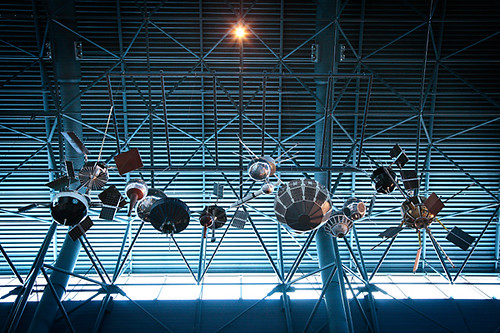
The museum was much larger than I expected. It's about the size of the Air and Space Museum on the National Mall, but much more open.
As with all the Smithsonian museums, admission was free. Parking was $15 though, some of which probably gets kicked back to the museum. This gets no complaints from me; they deserve it. I think the parking fee is also there to discourage people from using it as a parking lot for Dulles Airport, which is literally right next door.
I was very impressed with the way they had all the aircraft lit. Most museums seem to be satisfied with harsh top lighting, but not here. They had the undersides and crevices illuminated so everyone could appreciate (and photograph) the details of things like air intakes and landing gear. If you ever want to learn how to properly light an aircraft, you need to check it out.


I was impressed with how many aircraft they'd fit into a single building, though it did get out of hand at times (see left). I was especially looking forward to seeing the Concord, but was disappointed to see that it had so many other planes encroaching on it. The SR-71 and Enterprise were very well presented though, and it was great to see them in all their glory. Other favorites included the F-14 Tomcat, F-35 Lightning II (STOVL), TDRS satellite, and the New Horizons probe.
All in all, I only wish I'd allocated more time, and that I'd brought a wider lens. I only had my usual 24-105/4 with me, but the 17-40/4 seems like it would have been very useful in some of those spaces. On the flip side, the image stabilization came in very handy in all that low light. I generally had to shoot at ISO 800 and was getting shutter speeds below 1/30. Thanks to the reciprocal rule, this should be fine at 17mm, but would be pushing it at 40mm.
Anyway, whether you bring your camera with you or not, don't put it off like I did. Go check it out!

Sunday, August 23, 2009
Portage Lake
On August 6th, 2009, I had the opportunity to take the Gray Line tour of Portage Lake, south of Anchorage (map). From what I'm told, Portage Glacier is relatively small, as glaciers come. It looked big enough to me though. The deep shades of blue that were buried in the crevasses were amazing, even from a few hundred feet away. Overall the tour took about an hour. The tour is operated by a private company, but a Forest Service employee gives an excellent narration throughout the tour. It was a nice little side trip before I had to depart Alaska. I'd recommend it if you only have a little extra time in Anchorage.
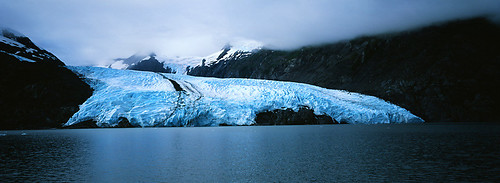

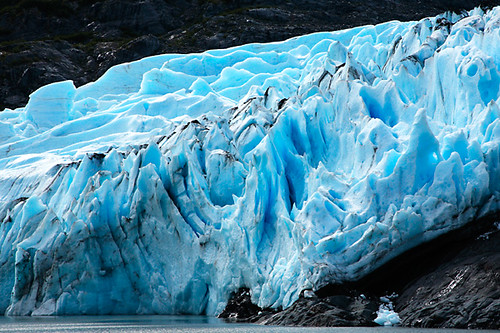
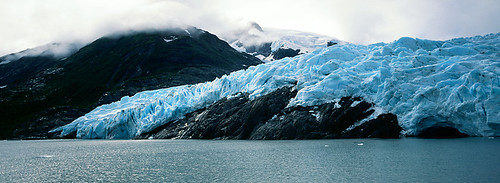






Friday, August 21, 2009
Zap
Ken Rockwell pointed out a simple way to get cool pictures of lightning with a point-and-shoot. With tonight's storms rolling through Baltimore, I thought I'd give it a try. I used my little Canon SD800 to get this shot about an hour ago.
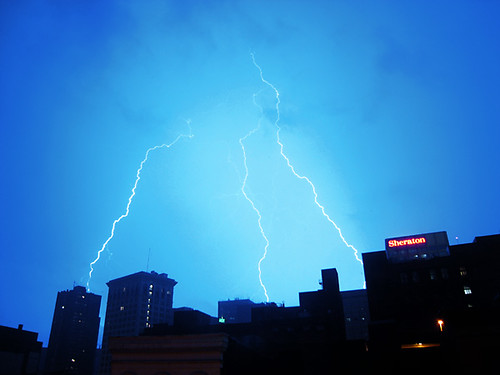
The building that's second from left is the Baltimore Gas and Electric (BGE) building. I guess they know some secret about lightning, because it seems to rarely strike their building... Hmm.
Anyway, I set the camera in manual with ISO 80, tungsten white balance, and continuous shooting mode. The camera automatically selected a shutter speed of 1 second. I then propped the camera up on the window sill and held down until I got something cool. It really does work, so give it a try.
Also, I'm kind of excited about the S90. Let's hope its as good as everyone says.

The building that's second from left is the Baltimore Gas and Electric (BGE) building. I guess they know some secret about lightning, because it seems to rarely strike their building... Hmm.
Anyway, I set the camera in manual with ISO 80, tungsten white balance, and continuous shooting mode. The camera automatically selected a shutter speed of 1 second. I then propped the camera up on the window sill and held down until I got something cool. It really does work, so give it a try.
Also, I'm kind of excited about the S90. Let's hope its as good as everyone says.
Thursday, August 20, 2009
Byron Glacier
Byron Glacier (trail head) is an easy, worthwhile stop south of Anchorage. It's very close to the Gray Line and Begich-Boggs Visitor Center. The trail is only about 0.8 miles long. It's a well-kept gravel trail that granny's motorized wheelchair could probably traverse. When you get there, don't be afraid to hike out across the rocks. Just don't get under any overhanging ice, as large chunks can break off and fall at random.
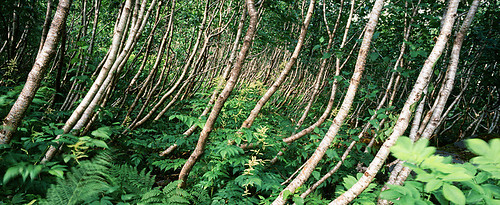
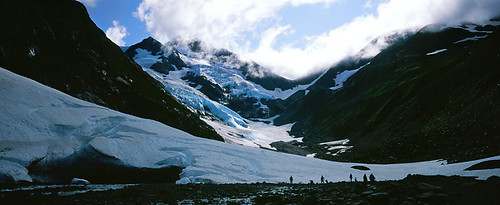
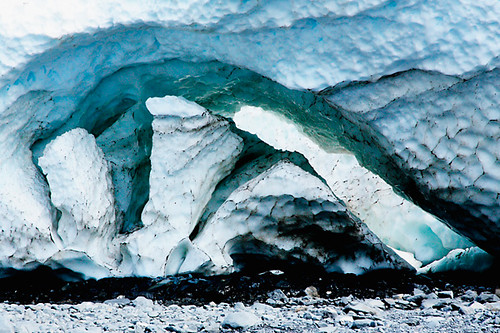



Tuesday, August 18, 2009
The Essential Notepad

I was reading the Lonely Planet Guide to Travel Writing today, and it reminded me of something I've been doing since at least 2006... carrying a notepad and pen. I know what you're thinking, "Haven't you ever heard of a PDA?" Of course, but an electronic gadget is often more trouble than it's worth for quick notes. I can keep the notepad in my back pocket for an entire year, sitting on it day after day, without fear of breaking it. A notepad doesn't need batteries or a connection to the Internet cloud. It doesn't need to boot up. It doesn't crash. It's also got convenient history and messaging functions; turn back a page or pass a note.
Obviously, the other essential item is a pen. I prefer the Zebra F-301 blue or black pens. They look sharp, handle well, and haven't failed me yet. The pen lives in my the left pocket (I'm left handed) of my jeans, clipped to the top, near the back. It stays put surprisingly well too, ready for the quick draw. My Swiss Army Knife also has a pen, but it's small and awkward, so it's strictly a backup. As a side note though, I heard Swiss Army officers were originally issued knives to sharpen their quills for record keeping.
And as you can tell from my blog, I've got a ways to go on my travel writing...
Williwaw trail
Williwaw trail, near Portage, has one of the nicest boardwalks I've ever seen. We stopped there for my last night in Alaska. Along the trail there are great places for viewing salmon and local plant life. I was amazed how green the Alaskan summer was. The plants apparently have to take full advantage of what little summer they get. Overall the campground was nice too, though the provided fire pits didn't allow any air in from below. We just made our fire outside the pit instead.
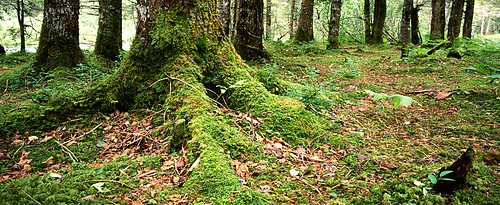
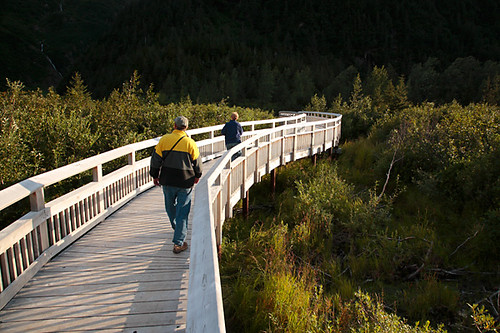
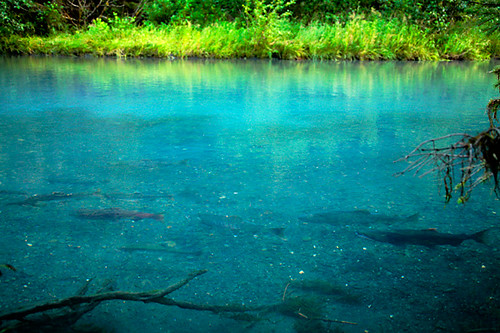

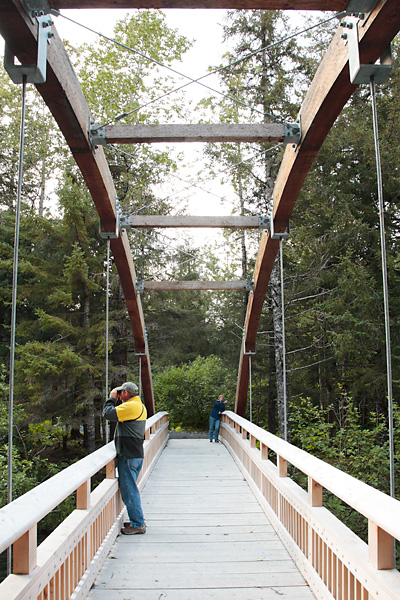





Wednesday, August 12, 2009
Mount McKinley
In case you didn't know, Mt. McKinley is big. In some ways, it's bigger than Mount Everest. It's usually enshrouded in clouds, but on the second day of my trip to Denali National Park, it fully revealed itself. Luckily, this was also the day that I was on the park shuttle bus to Wonder Lake (more on that in another post).
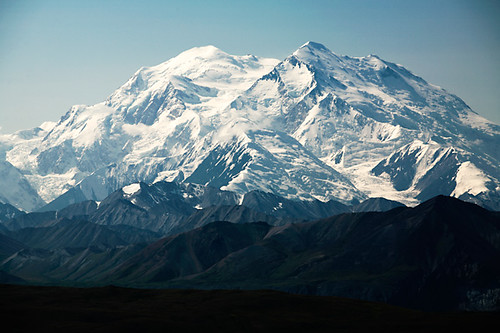
This uncropped shot was taken at 200mm on my 5D (full-frame sensor) from a distance of 33 miles, at Eielson Visitor Center. Thirty-three miles, and it still filled the frame. Those little mountains you see at its base are about 7,000 feet tall; not exactly small.
I'd thought about lugging my 400/5.6 on this trip, but it's probably better that I decided not to. There was quite a bit of haze in the air from regional forest fires, so there's only so much sharpness and detail you can achieve, no matter how long your lens is. I had to up the contrast quite a bit in this shot to get the level of detail you see now. Luckily, I remembered to expose to the right without blowing out all the highlights, so pulling back the color and contrast wasn't a huge problem when I got home.
If you make it up to Denali National Park, I hope you're lucky enough to see Mt. McKinley in all of its massively huge glory too. Happy trails.

This uncropped shot was taken at 200mm on my 5D (full-frame sensor) from a distance of 33 miles, at Eielson Visitor Center. Thirty-three miles, and it still filled the frame. Those little mountains you see at its base are about 7,000 feet tall; not exactly small.
I'd thought about lugging my 400/5.6 on this trip, but it's probably better that I decided not to. There was quite a bit of haze in the air from regional forest fires, so there's only so much sharpness and detail you can achieve, no matter how long your lens is. I had to up the contrast quite a bit in this shot to get the level of detail you see now. Luckily, I remembered to expose to the right without blowing out all the highlights, so pulling back the color and contrast wasn't a huge problem when I got home.
If you make it up to Denali National Park, I hope you're lucky enough to see Mt. McKinley in all of its massively huge glory too. Happy trails.
Tuesday, August 11, 2009
Pocket Ref

This is in no way related to Alaska, but I've been meaning to tell everyone about Thomas Glover's awesome little Pocket Ref. If you're planning to travel anywhere with less-than-stellar Internet availability (i.e. airplanes, Wyoming), then you need to drop a few bucks and get one of these. It's like having a little bit of Google, Wolfram Alpha, and Wikipedia in the palm of your hand. Want to know the difference between a cirrocummulus and a cumulonimbus cloud? Page 652 (with pictures). Want to know how to tie a blood knot? Page 537. Want to know the chemical composition of azurite? Page 342. Want to know how to convert from ounces to grams? Page 719. I could go on and on, but needless to say there's a lot of great stuff in this 5.6 ounce (158 gram) book. I found my copy at the bookstore hidden in with the dictionaries and thesauri. Check it out!
Monday, August 10, 2009
Savage Xpan
Ok, I've been bad about posting lately, but hey, I did just get back from Alaska. I plan to have several small posts about the trip in the coming weeks. I think it would take too long to write a huge post about the whole trip; just look at how long my PAGC post turned out to be.
In the meantime, I thought you might enjoy this shot I took through the viewfinder on my Hasselblad Xpan. It was taken at Savage Creek in Denali National Park a couple hours after sunrise. The yellow box in the middle is the parallax focus area. The mounted lens is the 45mm, which only blocks a small corner of the viewfinder.
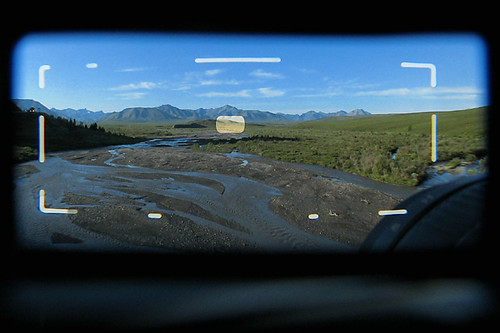
In case you were wondering, the shot through the viewfinder was taken with my little Canon SD800 in macro mode. Pretty cool.
In the meantime, I thought you might enjoy this shot I took through the viewfinder on my Hasselblad Xpan. It was taken at Savage Creek in Denali National Park a couple hours after sunrise. The yellow box in the middle is the parallax focus area. The mounted lens is the 45mm, which only blocks a small corner of the viewfinder.

In case you were wondering, the shot through the viewfinder was taken with my little Canon SD800 in macro mode. Pretty cool.
Saturday, August 1, 2009
Denali Air
I'm sitting in the back seat of a Piper Chieftain. The pilot fires up the two props and taxis out to the end of the grass strip. A quick 180 points the plane toward Denali National Park.
Full throttle. The small plane rises so gradually, that it's difficult to tell whether we're still rolling on the grass. A quick glance down reveals that all is well. The tips of the tress are indeed below, and I'm suddenly glad that Piper blessed the Chieftain with two engines, not one.
The pilot banks west over Parks Highway, the Alaska route 3. We pierce the park's invisible wilderness boundary line and throttle back. Ground below, clouds above, Mt. McKinley ahead.
The headset clicks. Our ascent and pre-recorded audio tour is suddenly interrupted by the pilot. Dall sheep on the cliffs at 3 o'clock... not below, straight out the window. Perhaps I should reach out and grab some wool, but the comfort of the enclosed cabin makes me think twice. The pilot comments on the joys of flying below the clouds, between the peaks, now that the weather has cleared. Indeed.
Surrounded by cliffs, glaciers, and mountain passes, our plane dips and banks to their every breath. My back and hips absorb the undulations as though I'm riding on the back of a horse. The lens hood on my 24-105/4 occasionally bumps the Plexiglass window in spite of my attempts at stability. As the vastness of patterns and colors outside reveal themselves, there are simply too many pictures to take. Image stabilization is a wonderful thing.
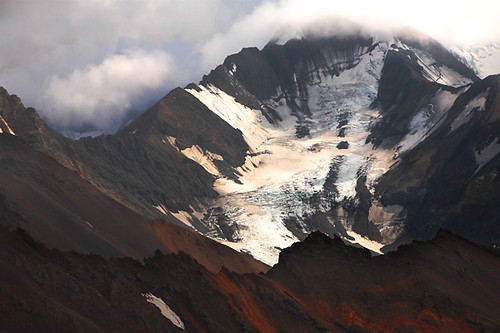

Suddenly, we've reached our destination. We're eye-to-eye with McKinley massif, or at least we should be. Clouds have moved in. The pilot offers to zoom us around to the west side of The Mountain in an attempt to get a clear view... for an extra $100 (each). A quick look at the clouds brings a quick consensus among the passengers. No thanks, McKinley can keep its cloudy reputation.
 Our course dwells momentarily as the plane turns slowly east. We're graced with the same amazing cliffs, glaciers, and mountain passes on our return, and my 5D continues to click away. As we approach the runway, I switch to taking video with the SD800; no need to "turn off all electronic devices" here, thank you very much.
Our course dwells momentarily as the plane turns slowly east. We're graced with the same amazing cliffs, glaciers, and mountain passes on our return, and my 5D continues to click away. As we approach the runway, I switch to taking video with the SD800; no need to "turn off all electronic devices" here, thank you very much.
The landing is as smooth and gradual as the takeoff; much smoother than I've felt on most commercial airliners. The Chieftain rolls to a stop, and the pilot shuts down the right engine. After all, there's no need to taxi with two engines after a perfect landing.
 The plane is returned to its patch of tarmac. The pilot turns around and finds nothing but smiling faces. He tells us a little about the plane. Its engines are overhauled every 2000 hours. It spends its winters (September to June) in Anchorage. Personsonally, I prefer to winter in Miami, but Anchorage seems sensible. The pilot also mentions that he's been flying at Denali for 27 years; almost my entire life. Good to know.
The plane is returned to its patch of tarmac. The pilot turns around and finds nothing but smiling faces. He tells us a little about the plane. Its engines are overhauled every 2000 hours. It spends its winters (September to June) in Anchorage. Personsonally, I prefer to winter in Miami, but Anchorage seems sensible. The pilot also mentions that he's been flying at Denali for 27 years; almost my entire life. Good to know.
After some pictures next to the plane, we return to the car. As we drive back to Riley Creek campground, we agree that Denali Air was a wise choice over the ATV tour. $250, 45 minutes, 180 pictures, and an unforgettable perspective of Denali; sounds like a deal to me.

Full throttle. The small plane rises so gradually, that it's difficult to tell whether we're still rolling on the grass. A quick glance down reveals that all is well. The tips of the tress are indeed below, and I'm suddenly glad that Piper blessed the Chieftain with two engines, not one.
The pilot banks west over Parks Highway, the Alaska route 3. We pierce the park's invisible wilderness boundary line and throttle back. Ground below, clouds above, Mt. McKinley ahead.
The headset clicks. Our ascent and pre-recorded audio tour is suddenly interrupted by the pilot. Dall sheep on the cliffs at 3 o'clock... not below, straight out the window. Perhaps I should reach out and grab some wool, but the comfort of the enclosed cabin makes me think twice. The pilot comments on the joys of flying below the clouds, between the peaks, now that the weather has cleared. Indeed.
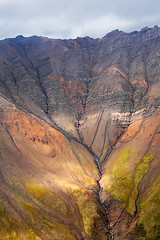 | 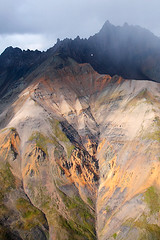 |
Surrounded by cliffs, glaciers, and mountain passes, our plane dips and banks to their every breath. My back and hips absorb the undulations as though I'm riding on the back of a horse. The lens hood on my 24-105/4 occasionally bumps the Plexiglass window in spite of my attempts at stability. As the vastness of patterns and colors outside reveal themselves, there are simply too many pictures to take. Image stabilization is a wonderful thing.


Suddenly, we've reached our destination. We're eye-to-eye with McKinley massif, or at least we should be. Clouds have moved in. The pilot offers to zoom us around to the west side of The Mountain in an attempt to get a clear view... for an extra $100 (each). A quick look at the clouds brings a quick consensus among the passengers. No thanks, McKinley can keep its cloudy reputation.
 Our course dwells momentarily as the plane turns slowly east. We're graced with the same amazing cliffs, glaciers, and mountain passes on our return, and my 5D continues to click away. As we approach the runway, I switch to taking video with the SD800; no need to "turn off all electronic devices" here, thank you very much.
Our course dwells momentarily as the plane turns slowly east. We're graced with the same amazing cliffs, glaciers, and mountain passes on our return, and my 5D continues to click away. As we approach the runway, I switch to taking video with the SD800; no need to "turn off all electronic devices" here, thank you very much.The landing is as smooth and gradual as the takeoff; much smoother than I've felt on most commercial airliners. The Chieftain rolls to a stop, and the pilot shuts down the right engine. After all, there's no need to taxi with two engines after a perfect landing.
 The plane is returned to its patch of tarmac. The pilot turns around and finds nothing but smiling faces. He tells us a little about the plane. Its engines are overhauled every 2000 hours. It spends its winters (September to June) in Anchorage. Personsonally, I prefer to winter in Miami, but Anchorage seems sensible. The pilot also mentions that he's been flying at Denali for 27 years; almost my entire life. Good to know.
The plane is returned to its patch of tarmac. The pilot turns around and finds nothing but smiling faces. He tells us a little about the plane. Its engines are overhauled every 2000 hours. It spends its winters (September to June) in Anchorage. Personsonally, I prefer to winter in Miami, but Anchorage seems sensible. The pilot also mentions that he's been flying at Denali for 27 years; almost my entire life. Good to know.After some pictures next to the plane, we return to the car. As we drive back to Riley Creek campground, we agree that Denali Air was a wise choice over the ATV tour. $250, 45 minutes, 180 pictures, and an unforgettable perspective of Denali; sounds like a deal to me.

Subscribe to:
Posts (Atom)

